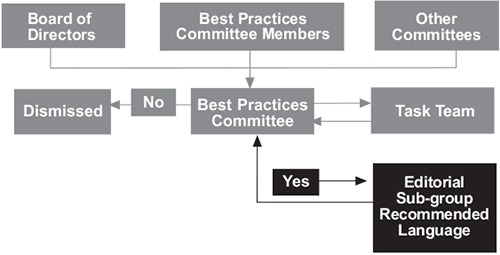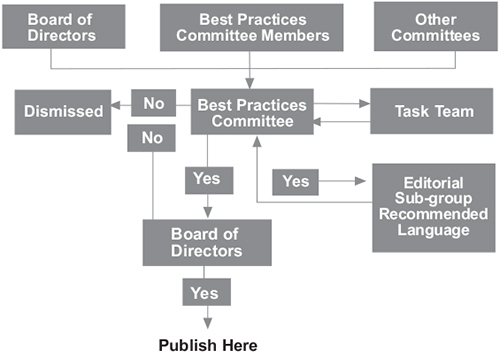Chapter 1
Best Practices Process


Anyone can submit a proposed best practice for review, either through their stakeholder group primary or directly to CGA staff. The Board of Directors as well as other CGA Committees may also submit proposed Best Practices.

The proposed Best Practice is brought before the next scheduled meeting of the Committee. This enables Committee members and their stakeholder group to review the proposal for discussion. The Committee reviews and discusses the proposal and decides whether it will be considered for Best Practices designation. If the Committee agrees to consider the practice, as task team is formed, and a transaction record is created.

The Task Team forwards the proposed Best Practice to the full Committee for consideration. In order to give each stakeholder group an opportunity to review the proposal, the Task Team must submit the proposed Best Practice at least 30 days before the next scheduled meeting. However, the Task Team is encouraged to submit as soon as possible for review by the full Committee. Each Stakeholder Primary is responsible for taking the proposal to their respective constituent group for review and position development. Each stakeholder group is asked to submit any questions, comments, concerns they may have with the proposed Best Practice before the next scheduled meeting convenes.

During the next scheduled meeting, the Task Team presents the proposed practice, which is comprehensively reviewed and discussed. The Committee decides whether the proposal is presented to the Board as a proposed Best Practice or whether it should go back to the Task Team for further consideration. It is not unusual for the practice to be sent back to the task team.

A Task Team is created using volunteers from the full Best Practices Committee, and a team chair is appointed. A cross-section of stakeholders is recommended for each task team to ensure input from as many stakeholder groups as possible.
A Transaction Record (TR) is created to track progress of the proposal from submission to the Task Team to the final decision on the proposed practice. The TR is numbered according to the year it is submitted to the Task Team (e.g., TR 2011), and a chronological acceptance for consideration during the year (i.e., if it was the first to be accepted, it would be numbered TR 2011-01, second TR 2011-02, and so on).
If the committee reaches consensus approval of the wording, the Best Practice is forwarded to the Editorial Task Team. The Editorial Task Team decides on the appropriate placement of the practice within the CGA Best Practices document and ensures that the language is consistent with Best Practice Committee protocols.

The final proposed Best Practice is then submitted to the Board of Directors for their consideration. If approved, the practice becomes a CGA Best Practice and is published in the manual. If not, the proposal is sent back to the Committee with comment.
If returned to the Committee, the proposal is reviewed (taking into account the Boards comments) and resubmitted as appropriate.

Once a Best Practice has been published, all stakeholders can rest assured it has been through the complete process.
The process ensures the integrity of Best Practices and their place in enhancing safety and keeping damaged to an ultimate minimum.
The Best Practice proposal form can be found by clicking the button below. A new Best Practice or an update to an existing Best Practice may be proposed.
Submit New Best Practice